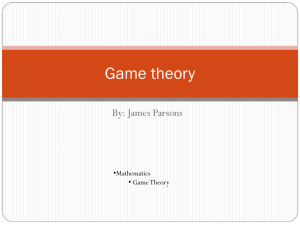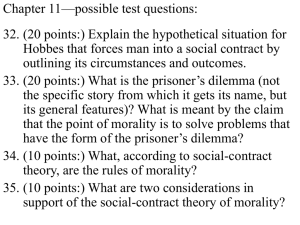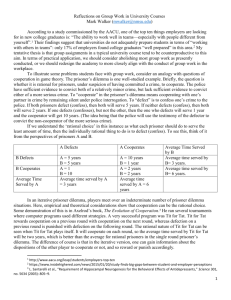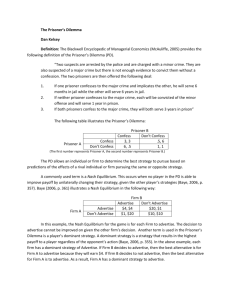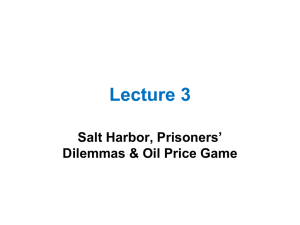ADAM SMITH (The Wealth of the Nations, 1776) intends
advertisement
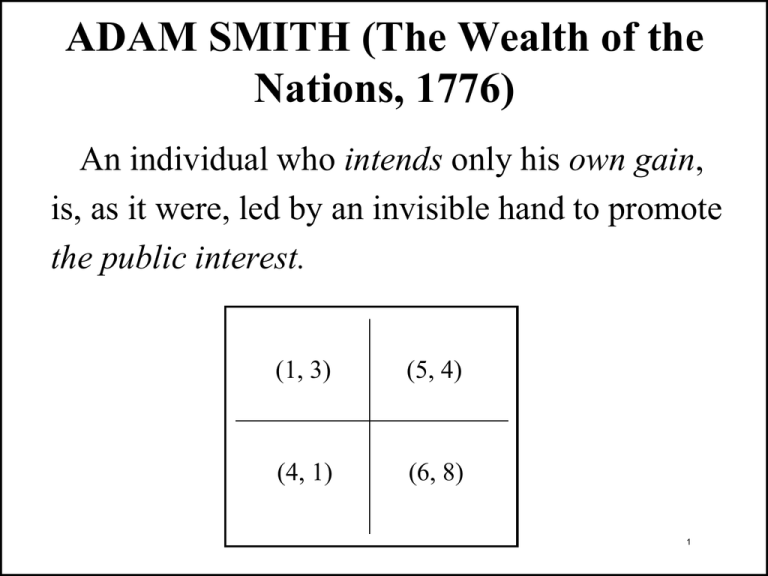
ADAM SMITH (The Wealth of the Nations, 1776) An individual who intends only his own gain, is, as it were, led by an invisible hand to promote the public interest. (1, 3) (5, 4) (4, 1) (6, 8) 1 Prisoner’s Dilemma A striking example of how individual rationality and group rationality may diverge. 2 “Peace has her victories no less renowned than war” - In a letter from John Milton to Lord General Cromwell “Prisoner’s Dilemma: The Drosophila of the social sciences” 3 TWO SUSPECTS ARE TAKEN INTO CUSTODY AND SEPARATED. THE DISTRICT ATTORNEY IS CERTAIN THAT THEY ARE GUILTY OF A SPECIFIC CRIME, BUT HE DOES NOT HAVE ADEQUATE EVIDENCE TO CONVICT THEM AT A TRIAL. HE POINTS OUT TO EACH PRISONER THAT EACH HAS TWO ALTERNATIVES: TO CONFESS TO THE CRIME THE POLICE ARE SURE THEY HAVE DONE, OR NOT TO CONFESS. IF THEY BOTH DO NOT CONFESS, THEN THE DISTRICT ATTORNEY STATES HE WILL BOOK THEM ON SOME VERY MINOR PUNISHMENT; IF THEY BOTH CONFESS THEY WILL BE PROSECUTED, BUT HE WILL RECOMMEND LESS THAN THE MOST SEVERE SENTENCE; BUT IF ONE CONFESSES AND THE OTHER DOES NOT, THEN THE CONFESSOR WILL RECEIVE LENIENT TREATMENT FOR TURNING STATE'S EVIDENCE WHEREAS THE LATTER WILL GET "THE BOOK" SLAPPED AT HIM. 4 The Prisoner’s Dilemma The PD is an important class of nonstrictly competitive situations where the best outcome results when the players refrain from trying to maximize his/her own payoff. Each player has a dominant strategy and the use of these dominant strategies leads to a “bad” outcome (i.e., Non-ParetoOptimal) 5 Prisoner’s Dilemma Problem Statement Two suspects: • A • B Two Alternatives: • Confess => C • Don’t Confess => DC 6 Prisoner’s Dilemma Payoff Table B C C (8, 8) DC (10, 1/2) A DC (1/2, 10) (1,1) Some observations: • This is a non-zero sum game • No matter what A does, B comes out ahead confessing. • No matter what B does, A comes out ahead confessing. For A, strategy C dominates DC strategy For B, strategy C dominates DC strategy • If each prisoner chooses his/her dominant strategy, they both lose. Both players would be better off if neither confess. 7 Pareto Optimality An outcome that is not dominated by any other outcome is called Pareto optimal. Pareto optimal strategy pairs are (DC,DC) (DC,C) and (C,DC) (1/2, 10) (8,8) (1,1) (10, 1/2) 8 What if Prisoners Could Communicate? Prisoners might choose strategy (DC,DC). • This, however, is not an equilibrium pair, since A and B can each do better by making a unilateral change of choice. • There is incentive to defect, but if both defect, then we are back where we started from. • Pre-choice communication cannot help in solving the dilemma unless there is some binding force (legal, moral, etc.) that holds the players to their agreement. 9 Prisoners and Paradoxes • It is “rational” for each player to confess. • There is no strategy that is best in all circumstances. • Problems such as this confuse our notion(s) of rationality. — Collective or group rationality vs. individual rationality • Forces us to resort to “Extra-rational” or “Meta-rational” notions (e.g., trust, conscience, etc.) 10 Applying the Prisoner’s Dilemma Economists use Prisoner’s Dilemma-type problems in analyzing market structures and competitive strategy. • PD-type problems are common in the real world. • PD creates price rigidity in oligopolistic markets. — Firms may be reluctant to change prices for fear of setting off a price war. • Price leadership as a way around the PD. 11 Iterative Prisoner’s Dilemma • Removes the static nature of the problem. • Allows players to: – Develop reputations – Study competitor’s behavior 12 When Individuals Meet Often: Axelrod Strategy: A rule that determines the probability of “cooperate” or “defect” as a function of history of interaction. WHAT STRATEGIES ARE: • Initially viable? • Robust? • Stable? 13 One Possible Strategy: “Tit for Tat” “Tit for Tat”: • First move is to cooperate. • Thereafter, mimic the last move of opponent. Infinite vs. Finite Trials: • In the infinite case, it always pays to cooperate. • Cooperative behavior is profitable in expected value terms, but depends upon the time horizon in question. 14 Why Does “Tit for Tat” Work? • Because it is nice (!) • Zero-sum myopia, i.e., score envy • Quick to anger, quick to forgive • Value of provocability • Value of clear and consistent strategies 15 Axelrod’s Genetic Algorithm (1985) • Simulation of evolution • Computer tournament • Round Robin (14 entries) • 2nd round (62 entries) WHAT HAPPENED? TIT FOR TAT DOMINATED! • • • • Don’t rock the boat! Be provocable! Forget & forgive! Accept a rut! “C” follows CCC “D” follows CCD “C” after DCC “D” after DDD 16 MIT OpenCourseWare http://ocw.mit.edu 15.067 Competitive Decision-Making and Negotiation Spring 2011 For information about citing these materials or our Terms of Use, visit: http://ocw.mit.edu/terms.

